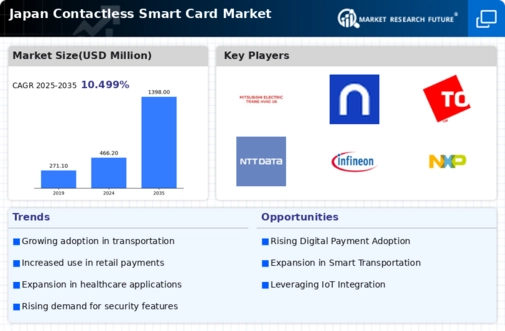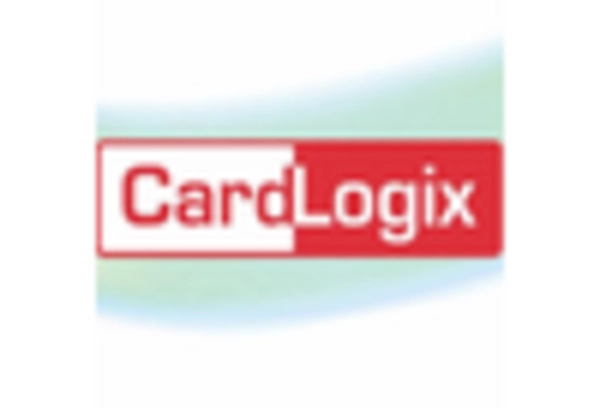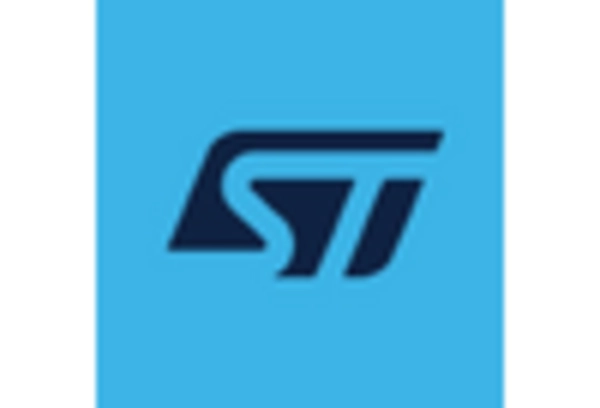Increased Focus on User Experience
The contactless smart-card market in Japan is witnessing a heightened focus on enhancing user experience, which is driving innovation and adoption. Companies are increasingly prioritizing the design and functionality of smart cards to ensure they meet consumer expectations for convenience and ease of use. As of 2025, it is estimated that user-friendly features, such as customizable designs and integration with mobile applications, will be key differentiators in the market. This emphasis on user experience is likely to attract a broader demographic, including younger consumers who value technology and personalization. The contactless smart-card market is thus positioned to evolve, catering to the diverse needs of its users while fostering greater engagement and loyalty.
Rising Demand for Contactless Payments
The contactless smart-card market in Japan is experiencing a notable surge in demand, primarily driven by the increasing preference for contactless payment methods among consumers. As of 2025, approximately 70% of Japanese consumers express a preference for contactless transactions, reflecting a significant shift in payment behavior. This trend is further supported by the growing number of retail establishments and service providers adopting contactless technology, which enhances convenience and speeds up transaction times. The contactless smart-card market is likely to benefit from this consumer inclination, as businesses strive to meet the evolving expectations of their clientele. Furthermore, the Japanese government has been promoting cashless initiatives, which may further bolster the adoption of contactless smart cards across various sectors, including retail, transportation, and hospitality.
Expansion of Public Transportation Systems
The expansion and modernization of public transportation systems in Japan are contributing to the growth of the contactless smart-card market. With cities like Tokyo and Osaka investing heavily in upgrading their transit infrastructure, the integration of contactless payment systems is becoming increasingly prevalent. As of 2025, it is projected that over 80% of public transport operators will offer contactless payment options, facilitating seamless travel experiences for commuters. This trend not only enhances convenience but also encourages the adoption of contactless smart cards among daily travelers. The contactless smart-card market is likely to see substantial growth as more individuals opt for these cards to navigate urban transit systems efficiently.
Technological Advancements in Card Security
Technological innovations in security features are playing a crucial role in shaping the contactless smart-card market in Japan. With the rise in digital transactions, the demand for enhanced security measures has become paramount. The introduction of advanced encryption technologies and biometric authentication methods is likely to instill greater confidence among consumers and businesses alike. As of 2025, it is estimated that around 60% of new contactless smart cards will incorporate these advanced security features, addressing concerns related to fraud and data breaches. This trend indicates a proactive approach within the contactless smart-card market to ensure the safety of transactions, thereby fostering consumer trust and encouraging wider adoption of contactless payment solutions.
Government Initiatives Supporting Cashless Transactions
The Japanese government is actively promoting cashless transactions, which is significantly impacting the contactless smart-card market. Initiatives such as subsidies for businesses adopting cashless payment systems and campaigns to encourage consumer usage are likely to drive market growth. As of 2025, government reports suggest that cashless transactions could account for over 40% of total retail sales in Japan. This supportive regulatory environment is expected to create a favorable landscape for the contactless smart-card market, as it aligns with the broader economic goals of enhancing efficiency and reducing reliance on cash. The collaboration between public and private sectors in promoting contactless payment solutions may further accelerate the adoption of smart cards across various industries.
















Leave a Comment